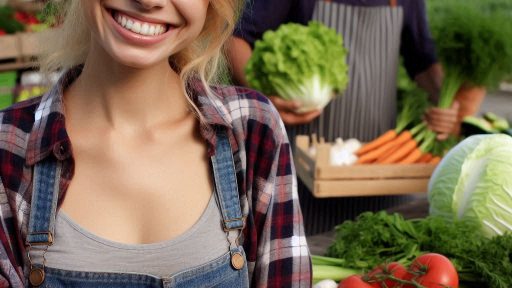Introduction
In urban farming, agricultural activities take place within city limits, utilizing rooftops, vacant lots, or community gardens.
City Grower Mike is a passionate advocate for urban agriculture, pioneering sustainable farming practices within urban landscapes.
He believes urban farming offers numerous benefits, including increased access to fresh produce, community engagement, and food security.
Through his innovative approach, Mike demonstrates how urban farming can transform underutilized urban spaces into thriving food-producing areas.
As a leading figure in the urban farming movement, Mike shares his expertise and experiences to inspire others.
He aims to empower individuals and communities to grow their food, promoting self-sufficiency and resilience.
Through workshops, educational programs, and partnerships with local organizations, Mike educates urban dwellers on the principles of urban farming.
He emphasizes the importance of resource efficiency, composting, and sustainable cultivation methods in urban agriculture.
By integrating technology and traditional farming practices, Mike maximizes productivity while minimizing environmental impact.
He envisions a future where urban farming is an integral part of urban planning, contributing to greener, healthier cities.
With his urban farm, Mike demonstrates that agriculture can thrive even in the concrete jungle.
Through his passion and dedication, he is reshaping the urban landscape, one garden at a time.
Background on Urban Farming
Urban farming refers to the practice of cultivating, processing, and distributing food in or around cities.
Definition of urban farming
- Urban farming is the process of growing crops and raising animals within urban areas, including rooftops, balconies, and community gardens.
- It is a sustainable approach that enables individuals and communities to produce their food.
Brief history of urban farming
- Urban farming has a long history, dating back to ancient civilizations such as the Aztecs and Romans, who cultivated rooftop gardens.
- In the 19th century, urban farming became popular in response to increasing urbanization and a desire for self-sufficiency during economic downturns.
- During World War II, victory gardens were promoted to alleviate food shortages, and urban farming gained further momentum.
- In recent years, there has been a resurgence of interest in urban farming, driven by environmental concerns, food security issues, and a desire for healthier, locally sourced food.
Importance and benefits of urban farming
Environmental benefits
- Urban farming reduces the need for long-distance transportation, minimizing carbon emissions and air pollution.
- By cultivating food in urban areas, we can preserve agricultural land and protect delicate ecosystems from further encroachment.
- Urban farms can also contribute to urban greening initiatives, promoting biodiversity and improving air and water quality.
Social and community benefits
- Urban farming promotes community engagement and fosters social connections through shared gardening spaces and farmer’s market events.
- It provides opportunities for education and skill-building, offering urban residents the chance to learn about agriculture and sustainable practices.
- Community gardens and urban farms can serve as safe and accessible spaces for exercise, recreation, and relaxation.
Economic benefits
- Urban farming can generate income and economic opportunities for local communities through the sale of fresh produce and value-added products.
- It can contribute to local employment by creating jobs in farming, distribution, and marketing.
- Urban farms can also help reduce food insecurity and improve access to fresh, nutritious food in underserved neighborhoods.
In essence, urban farming is a growing movement that offers numerous benefits to individuals, communities, and the environment.
By cultivating food in urban areas, we can promote sustainability, foster community engagement, and enhance local economies.
Transform Your Agribusiness
Unlock your farm's potential with expert advice tailored to your needs. Get actionable steps that drive real results.
Get StartedWith its rich history and promising future, urban farming is proving to be a vital solution to the challenges of food production and distribution in our rapidly urbanizing world.
Read: From Seed to Table: A Day with Paul
Interview with City Grower Mike
Background information on City Grower Mike
City Grower Mike has a passion for sustainable agriculture and a deep love for cities.
Raised in a concrete jungle, Mike was always drawn to nature. He studied horticulture and gained experience in traditional farming.
Reasons why City Grower Mike got into urban farming
Mike realized the potential of using urban spaces to grow food, reducing the carbon footprint and increasing food security.
He saw the need for change in the current food system and believed that urban farming offered a viable solution.
Challenges faced by urban farmers like City Grower Mike
Limited space, environmental pollution, and access to resources are some of the challenges urban farmers face.
Urban farms often face zoning restrictions, lack of awareness, and limited community support, making it harder to thrive.
Successful projects and initiatives by City Grower Mike
Despite the challenges, City Grower Mike has successfully transformed vacant lots into thriving urban farms.
He initiated community gardens and partnered with local restaurants to provide them with fresh, locally-grown produce.
City Grower Mike’s goals and vision for the future
- City Grower Mike envisions a future where every neighborhood has its urban farm, providing fresh produce to the community.
- He aims to educate and inspire others to embrace urban farming, advocating for policy changes to support sustainable agriculture in cities.
- By implementing rooftop gardens and vertical farming, he wants to maximize food production while minimizing environmental impact.
- City Grower Mike’s ultimate goal is to create a sustainable and resilient food system that benefits both people and the planet.
City Grower Mike, with his passion, knowledge, and determination, is leading the way toward a greener and healthier future for urban communities.
Read: The Organic Pioneer: Linda’s Legacy
Benefits and Impact of Urban Farms
Environmental benefits of urban farming
- Reduces greenhouse gas emissions through local production and shorter transportation distances.
- Improves air quality by absorbing carbon dioxide and releasing oxygen.
- Minimizes urban heat island effect by providing shade and cooling the environment.
- Reduces water pollution by minimizing runoff and improving water filtration through soil and plant absorption.
- Promotes biodiversity by providing habitats for various plants, insects, and animals.
Social and community impact of urban farms
- Enhances community engagement and social cohesion, fostering relationships between neighbors and residents.
- Provides educational opportunities for children and adults to learn about food production and sustainable practices.
- Creates public spaces that promote physical activity and mental well-being.
- Improves food access and equity by bringing fresh produce to underserved neighborhoods.
- Brings diverse communities together, fostering cultural exchange and celebrating local traditions.
Economic advantages of urban farming
- Creates job opportunities for residents, especially in areas with limited employment options.
- Supports local economies by keeping food production, distribution, and sales within the community.
- Helps revitalize abandoned or underutilized urban spaces, increasing property values and attracting businesses.
- Reduces reliance on external food sources, thus reducing vulnerability to price fluctuations and supply chain disruptions.
- Stimulates entrepreneurship and innovation, encouraging the development of new agricultural technologies and practices.
Potential to combat food insecurity and promote healthy eating
- Increases access to fresh, nutritious food, especially for low-income communities with limited grocery store options.
- Addresses food deserts by establishing local markets and community-supported agriculture programs.
- Encourages the consumption of fruits, vegetables, and herbs, leading to improved dietary habits and overall health.
- Empowers individuals to take control of their food choices and cultivate a deeper understanding of nutrition.
- Promotes self-sufficiency and food sovereignty, giving individuals the ability to grow their food and reduce dependence on external sources.
In a nutshell, urban farms offer numerous benefits and have a significant impact on the environment, society, economy, and food security.
Read: Family Farm Life: The Smiths’ Tale

Gain More Insights: Greenhouse Gases & Farming
Examples of Successful Urban Farms
Case Study 1: Brooklyn Grange Rooftop Farm
- Brooklyn Grange Rooftop Farm, located in New York City, is one of the largest rooftop farms in the world.
- The farm runs various initiatives and projects to promote sustainable agriculture and community engagement.
- Through their educational programs, Brooklyn Grange has educated thousands of children and adults about urban farming.
- The farm also provides fresh, organic produce to local restaurants and farmers’ markets, contributing to the local food system.
- In addition, Brooklyn Grange has transformed previously unused rooftop spaces into thriving green spaces, helping to mitigate the urban heat island effect.
- The farm’s impact on the community is evident in the increased awareness and appreciation for locally grown, sustainable food.
- Moreover, the farm has created job opportunities and local economic growth, further strengthening the community.
Case Study 2: Growing Power
- Growing Power, based in Milwaukee, Wisconsin, is a nonprofit urban farm that focuses on food justice and accessibility.
- The farm utilizes innovative farming techniques, such as vertical farming and aquaponics, to maximize space and efficiency.
- One of the unique features of Growing Power is its dedication to providing accessible, affordable food to underserved communities.
- The farm has successfully established a network of urban farms and farmers’ markets, ensuring fresh produce is available in food deserts.
- Growing Power has also launched a training program called the Growing Power Milwaukee Program, which educates individuals on urban farming and food systems.
- Many success stories have emerged from Growing Power, with individuals from disadvantaged backgrounds finding stable employment and a sense of purpose.
- These success stories highlight the transformative power of urban farming in creating opportunities for personal and community growth.
- Growing Power’s commitment to sustainability and social justice has had a ripple effect, inspiring other urban farms across the country.
In short, urban farms like Brooklyn Grange Rooftop Farm and Growing Power serve as shining examples of successful initiatives in sustainable agriculture and community engagement.
These farms not only provide fresh produce but also educate and empower individuals, strengthen local economies, and foster a sense of community.
The impact of urban farming extends far beyond the boundaries of the farm itself, creating a more resilient, sustainable, and just food system for urban communities.
You Might Also Like: The Eco-Impact of Organic Food Choices
Tips and Resources for Starting an Urban Farm
Necessary resources and equipment
- Start with basic gardening tools like shovels, rakes, watering cans, and gloves.
- Invest in high-quality soil, compost, and organic fertilizers for healthy plant growth.
- Consider purchasing raised beds, containers, or hydroponic systems based on your available space.
- Insecticides, pesticides, and protective netting may be needed to combat pests and ensure crop protection.
- Utilize tools such as wheelbarrows, sprinklers, and trellises to make farm maintenance easier.
Finding suitable land or space for urban farming
- Look for vacant lots, rooftops, or unused spaces in your city that can be transformed into productive farms.
- Approach local property owners or city officials to secure permissions for farming on public or private lands.
- Consider joining community gardens or leasing land from organizations specializing in urban agriculture.
- Explore vertical farming techniques and grow plants indoors or on walls to maximize space utilization.
Building a support network and partnering with local organizations
- Connect with local farmers, gardening groups, or agricultural nonprofits to learn from their experiences.
- Attend farmer’s markets, food fairs, or sustainability events to meet like-minded individuals and potential partners.
- Collaborate with local restaurants, grocery stores, or food cooperatives to establish a market for your produce.
- Engage with city councils, environmental groups, or community associations to advocate for urban farming initiatives.
Accessing funding and grants for urban farming ventures
- Research government grants, loans, and subsidies are available specifically for urban agriculture projects.
- Explore crowdfunding platforms or seek sponsorship from businesses interested in supporting sustainable initiatives.
- Approach local foundations, agricultural banks, or agricultural extension offices for funding opportunities.
- Develop a comprehensive business plan to present to potential investors or financial institutions for funding consideration.
Resources and websites for further information and guidance
- Urban Farming Institute: www.urbanfarminginstitute.org
- The Sprout Urban Farms: www.thesprouturbanfarms.com
- City Farmer: www.cityfarmer.org
- American Community Gardening Association: www.communitygarden.org
- USDA Urban Agriculture Toolkit: www.usda.gov/urbanagriculture
By utilizing these tips and resources, aspiring urban farmers can lay a strong foundation for their ventures.
Remember, starting small and seeking guidance from experienced individuals and organizations will be key to a successful urban farming journey.
Good luck on your path toward sustainable and local food production!
Read: Farm Innovations: Alex’s High-Tech Field
Find Out More: Farm-to-Table Seminars for Beginners
Showcase Your Farming Business
Publish your professional farming services profile on our blog for a one-time fee of $200 and reach a dedicated audience of farmers and agribusiness owners.
Publish Your ProfileConclusion
Throughout this blog post, we have delved into the fascinating world of urban farming.
We explored the benefits of growing food in cities, such as increasing access to fresh produce, reducing environmental impact, and fostering community engagement.
We also learned about the challenges involved in urban farming, including limited space, soil quality, and zoning regulations.
If you have been inspired by the concept of urban farming, we encourage you to explore the opportunities available in your city.
Consider joining a community garden, starting a rooftop garden, or even converting vacant land into productive farming spaces.
By participating in urban farming, you can not only nourish yourself and your community but also contribute to the sustainability of our planet.
As urbanization continues to shape our world, the potential of urban farming is limitless.
By utilizing innovative techniques such as hydroponics, vertical farming, and aquaponics, we can maximize food production in urban areas.
As more people become aware of the importance of local and sustainable food systems, we can expect urban farming to gain even more traction.
With the integration of technology and strategic urban planning, the future of urban farming looks bright.
In closing, urban farming has emerged as a viable solution to the challenges of food security, environmental sustainability, and community resilience in cities.
By embracing the practice of growing food in urban areas, we can build stronger and more sustainable communities while reducing our ecological footprint.
So why not grab a shovel and get involved in the urban farming movement today? Your city, your community, and your planet will thank you.




